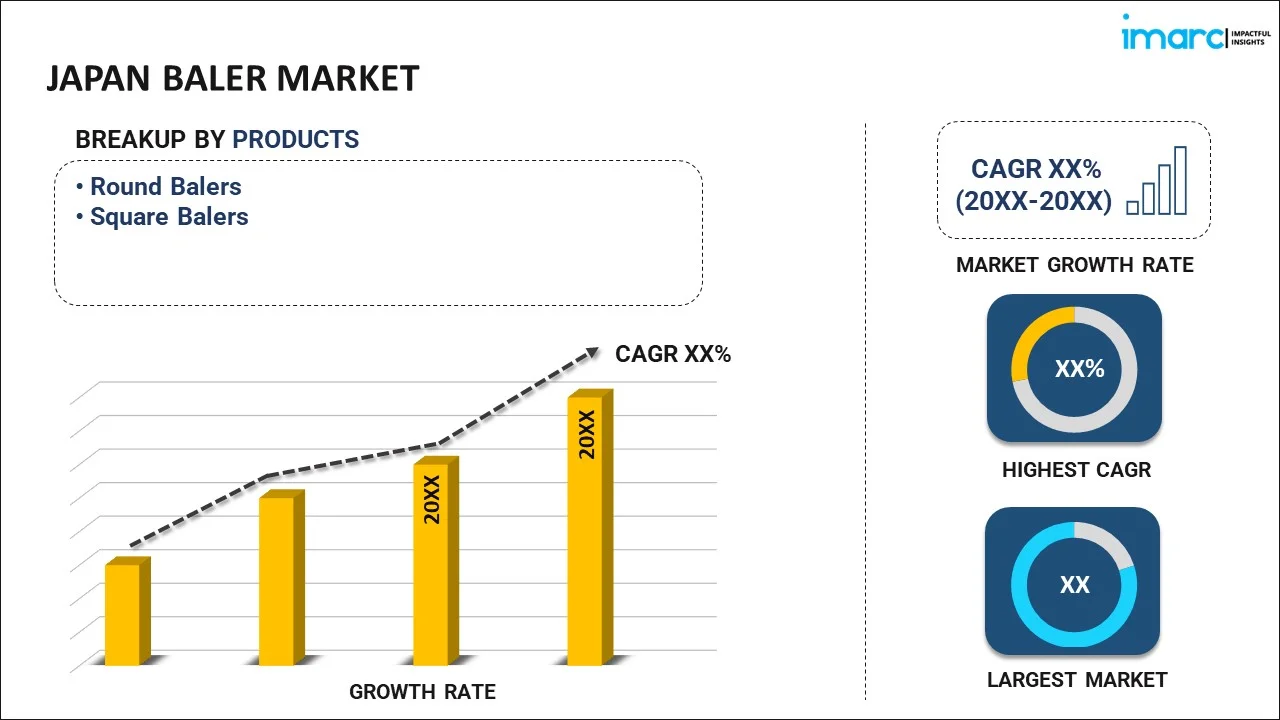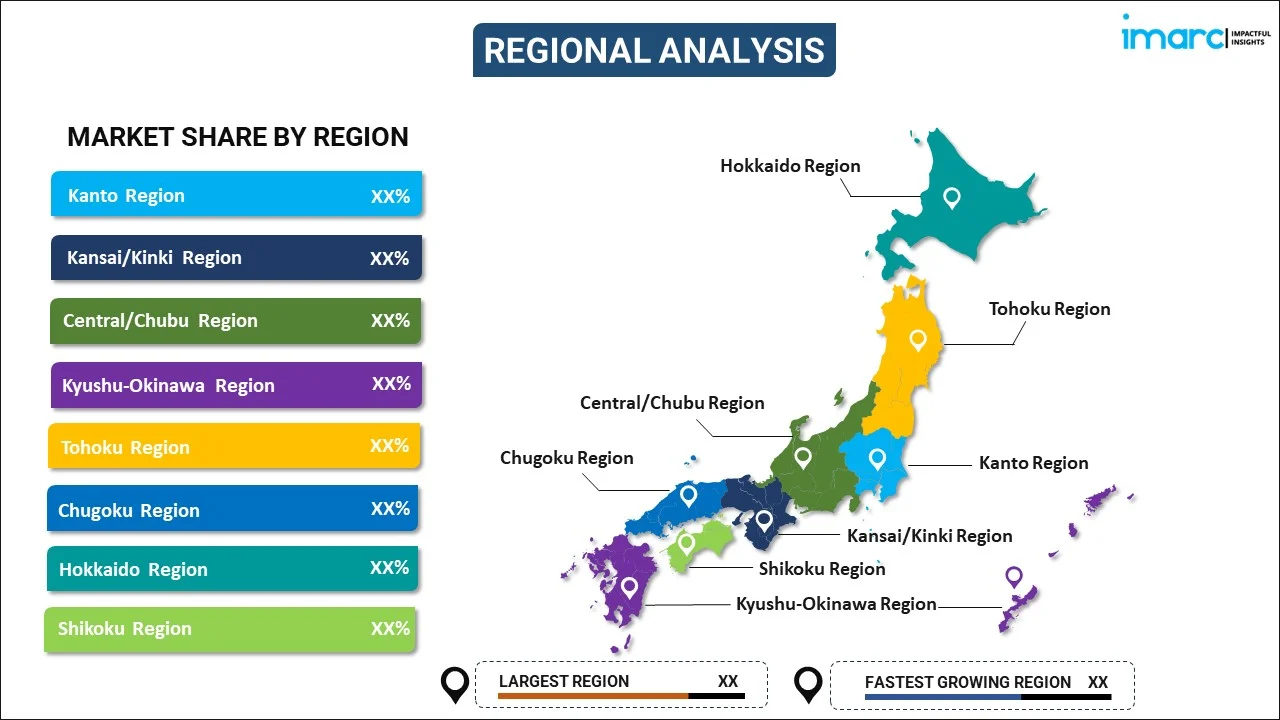
Japan Baler Market Report by Product (Round Balers, Square Balers), Distribution Channel (Online, Offline), Application (Agriculture, Livestock Industry, and Others), End User (Individual, Commercial, Industrial), and Region 2025-2033
Market Overview:
Japan baler market size reached USD 295.7 Million in 2024. Looking forward, IMARC Group expects the market to reach USD 580.2 Million by 2033, exhibiting a growth rate (CAGR) of 7.8% during 2025-2033. The growing utilization of smart farming methods for effectively utilizing crop residue and improving farm yield is primarily driving the market growth.
|
Report Attribute
|
Key Statistics
|
|---|---|
|
Base Year
|
2024
|
|
Forecast Years
|
2025-2033
|
|
Historical Years
|
2019-2024
|
|
Market Size in 2024
|
USD 295.7 Million |
|
Market Forecast in 2033
|
USD 580.2 Million |
| Market Growth Rate 2025-2033 | 7.8% |
A baler is a mechanical apparatus employed for the purpose of cutting and compacting harvested crops, including but not limited to hay, cotton, flax straw, and silage, into compact bales of various shapes, such as squares, spheres, or rectangles. These bales offer the advantages of ease in handling, transportation, and storage. Baler equipment is typically available in two primary variants: chain-based and belt-based. Chain balers utilize connecting bars, chains, and rollers situated at the chamber's bottom to rotate and process the material, while belt balers incorporate a series of rollers and belts for the same purpose. These machines are typically constructed using sheet steel and comprise various components, including hydraulic cylinders, pumps, tires, wheels, and belts. Moreover, they play a role in preserving the nutritional value of the bundled crops and are versatile enough to create bales from materials such as plastic, paper, fiberboard, cans, and foil waste.
Japan Baler Market Trends:
The Japan baler market is experiencing significant growth, driven by several pivotal factors that align with the evolving landscape of the agriculture and recycling sectors. A primary driver is the substantial expansion observed in the agriculture industry, accompanied by the increasing adoption of automation in agricultural infrastructure. Farmers are increasingly turning to balers to efficiently manage crop residue, enhance soil productivity, and optimize agricultural processes. Furthermore, the emergence of metal recycling balers represents another substantial growth catalyst in the market. These balers offer a cost-effective solution to recycling metal, thereby reducing energy consumption and diminishing reliance on mining for metal resources. This sustainability-focused approach resonates with environmental and economic considerations. In addition, the development of innovative baler equipment featuring enhanced mechanized capabilities contributes to market growth by improving efficiency and productivity in various applications. Several other factors bolster the market's prospects, including the rising consumer spending capacity and the implementation of favorable government policies that promote sustainable agricultural practices. These factors will collectively position the Japan baler market for continued growth in the coming years.
Japan Baler Market Segmentation:
IMARC Group provides an analysis of the key trends in each segment of the market, along with forecasts at the country level for 2025-2033. Our report has categorized the market based on product, distribution channel, application, and end user.
Product Insights:

- Round Balers
- Square Balers
The report has provided a detailed breakup and analysis of the market based on the product. This includes round balers and square balers.
Distribution Channel Insights:
- Online
- Offline
A detailed breakup and analysis of the market based on the distribution channel have also been provided in the report. This includes online and offline.
Application Insights:
- Agriculture
- Livestock Industry
- Others
The report has provided a detailed breakup and analysis of the market based on the application. This includes agriculture, livestock industry, and others.
End User Insights:
- Individual
- Commercial
- Industrial
A detailed breakup and analysis of the market based on the end user have also been provided in the report. This includes individual, commercial, and industrial.
Regional Insights:

- Kanto Region
- Kansai/Kinki Region
- Central/ Chubu Region
- Kyushu-Okinawa Region
- Tohoku Region
- Chugoku Region
- Hokkaido Region
- Shikoku Region
The report has also provided a comprehensive analysis of all the major regional markets, which include Kanto Region, Kansai/Kinki Region, Central/ Chubu Region, Kyushu-Okinawa Region, Tohoku Region, Chugoku Region, Hokkaido Region, and Shikoku Region.
Competitive Landscape:
The market research report has also provided a comprehensive analysis of the competitive landscape. Competitive analysis such as market structure, key player positioning, top winning strategies, competitive dashboard, and company evaluation quadrant has been covered in the report. Also, detailed profiles of all major companies have been provided.
Japan Baler Market Report Coverage:
| Report Features | Details |
|---|---|
| Base Year of the Analysis | 2024 |
| Historical Period | 2019-2024 |
| Forecast Period | 2025-2033 |
| Units | Million USD |
| Scope of the Report | Exploration of Historical and Forecast Trends, Industry Catalysts and Challenges, Segment-Wise Historical and Predictive Market Assessment:
|
| Products Covered | Round Balers, Square Balers |
| Distribution Channels Covered | Online, Offline |
| Applications Covered | Agriculture, Livestock Industry, Others |
| End Users Covered | Individual, Commercial, Industrial |
| Regions Covered | Kanto Region, Kansai/Kinki Region, Central/ Chubu Region, Kyushu-Okinawa Region, Tohoku Region, Chugoku Region, Hokkaido Region, Shikoku Region |
| Customization Scope | 10% Free Customization |
| Post-Sale Analyst Support | 10-12 Weeks |
| Delivery Format | PDF and Excel through Email (We can also provide the editable version of the report in PPT/Word format on special request) |
Key Questions Answered in This Report:
- How has the Japan baler market performed so far and how will it perform in the coming years?
- What has been the impact of COVID-19 on the Japan baler market?
- What is the breakup of the Japan baler market on the basis of product?
- What is the breakup of the Japan baler market on the basis of distribution channel?
- What is the breakup of the Japan baler market on the basis of application?
- What is the breakup of the Japan baler market on the basis of end user?
- What are the various stages in the value chain of the Japan baler market?
- What are the key driving factors and challenges in the Japan baler?
- What is the structure of the Japan baler market and who are the key players?
- What is the degree of competition in the Japan baler market?
Key Benefits for Stakeholders:
- IMARC’s industry report offers a comprehensive quantitative analysis of various market segments, historical and current market trends, market forecasts, and dynamics of the Japan baler market from 2019-2033.
- The research report provides the latest information on the market drivers, challenges, and opportunities in the Japan baler market.
- Porter's five forces analysis assist stakeholders in assessing the impact of new entrants, competitive rivalry, supplier power, buyer power, and the threat of substitution. It helps stakeholders to analyze the level of competition within the Japan baler industry and its attractiveness.
- Competitive landscape allows stakeholders to understand their competitive environment and provides an insight into the current positions of key players in the market.
Need more help?
- Speak to our experienced analysts for insights on the current market scenarios.
- Include additional segments and countries to customize the report as per your requirement.
- Gain an unparalleled competitive advantage in your domain by understanding how to utilize the report and positively impacting your operations and revenue.
- For further assistance, please connect with our analysts.
 Inquire Before Buying
Inquire Before Buying
 Speak to an Analyst
Speak to an Analyst
 Request Brochure
Request Brochure
 Request Customization
Request Customization




.webp)




.webp)












